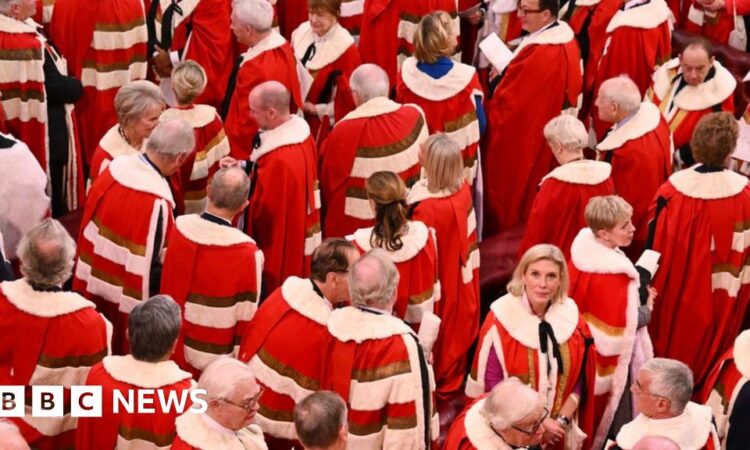
Image source, Leon Neal/PA Media
Charles III delivered his first Kings speech from the throe in the House of Lords in November 2023
The House of Lords could be abolished if Labour wins the next general election.
The Lords chamber is centuries old, and replacing it would be a huge change to the UK’s political system.
What is the House of Lords?
The House of Lords is part of the UK Parliament. Also known as the Upper Chamber, it is independent from the House of Commons – where 650 Members of Parliament (MPs) debate and vote on new laws.
Members of the Lords are called “peers”. Like MPs, they scrutinise the work of government and recommend changes to proposed legislation.
Unlike MPs, however, peers are not elected. The majority are appointed by the monarch on the advice of the prime minister.
While many peers have worked in politics – including some former MPs – others are experts in areas such as science or the arts.
Most peers stay in the Lords for life – although some choose to retire.
How many members sit in the House of Lords?
The House of Lords does not have a fixed number of seats, and its size fluctuates as members leave and join.
In December, there were 784 peers, making the House of Lords the second largest parliamentary chamber in the world. Only China’s National People’s Congress is bigger.
The current chamber includes:
- 270 Conservative peers
- 175 Labour
- 80 Liberal Democrats
- 6 Democratic Unionist Party
- 2 Ulster Unionist Party
- 2 Green Party
- 1 Plaid Cymru
There are also 183 Crossbenchers – peers who are not affiliated to a particular party – and 26 bishops.
In total, there are 556 male peers and 228 female peers.
Image source, Getty Images
Who sits in the House of Lords?
In December 2023, there were 667 appointed life peers and 91 hereditary peers.
In June 2023, the House of Commons Public Administration and Constitutional Affairs Committee launched another inquiry into the Lords. It will consider its size, how peers are appointed and their role and responsibilities.
How much do Lords get paid?
Most Lords are entitled to a £342 daily allowance for each sitting day attended – although they can choose not to claim.
Some also receive a salary – like the Lord Speaker and government ministers. Salaried peers cannot claim the daily allowance.
What could replace the House of Lords?
It could have around 200 members from across the UK but the way they would be chosen or the length of their term has not been decided.
Sir Keir says the new system could be introduced within the first five years of a Labour government.
What are the problems with replacing the House of Lords?
Former Cabinet Minister Simon Clarke MP was highly critical of Labour’s plan:
“Anyone who has looked at the institutionalised gridlock in US politics can see the utter stupidity it would be to create an elected upper house.”
Political gridlock can make it difficult to pass new legislation.
Abolishing the Lords could also result in a loss of expertise, says Jess Sargeant from the Institute for Government think tank:
“An appointments system can bring in experts – like former doctors and supreme court judges [who may not] be willing to stand in an election.”
If the new chamber’s members considered themselves more representative of the UK than MPs, they may undermine the Commons by blocking new legislation, adds Ms Sargeant.
How do other countries’ upper chambers work?
- US: The US Senate has 100 elected members who serve six-year terms. A third of the membership is elected every two years
- Canada: The Canadian Senate has 105 members and mandatory retirement age of 75. Like the Lords, its members are appointed on the recommendation of the PM
- France: The French Senate has 348 elected members who serve six-year terms. Half are up for election every three years
